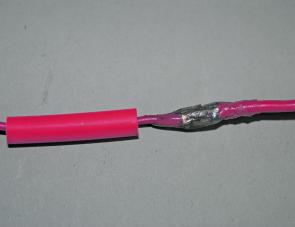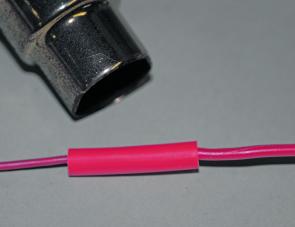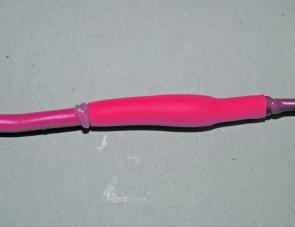TheBigGuy
Well-Known Member
Well I've been working on my boat for weeks. Started as a simple bilge pump replacement and ended up being a major project. I've upgraded my fuel system, electrical system, battery housings etc, etc, etc. I had no intention of doing all the work I've done at this time of year, but one thing led to another, and another. I've just about finished now, but I thought I'd share my method for making a watertight electrical connection in case it might help other guys.
I have no idea if my method is unique, but I've never read about it anywhere else. Maybe others have a different way that is even better, but I've found this method pretty good for maintaining a solid long lasting watertight electrical connection.
First off, if your not into soldering this method probably isn't for you. Although the procedure can be used without soldering. For any submerged connection I generally solder. I may use a butt connector if it's large gauge wire, but I generally solder the two wires together. Sometimes if it is not submerged I will crimp on a terminal, but I will still usually solder the terminal after crimping.
The next part is what leads to a rock solid watertight connection. I use a glue gun with the plastic glue sticks to cover the wire connection with a large coating of glue over the solder joint. Next I use a heat gun to even out the coating of glue over the connection. The glue should cover the connection and at least 2 inches on either side of the joint. Next use a an appropriate size of heat shrink tubing to completely cover the joint and and the several inches of glue on either side. If the tubing won't quite slide over the glue, use the heat gun to even out the coating of glue until the heat shrink tube will slide over top. Make sure the glue has cooled before you try sliding the tubing over top, or it will start to shrink before you get it in place. Once the shrink tube is in place, hit it with the heat gun on a medium heat setting. Heat around the shrink tube evenly starting in the center. The glue underneath the shrink tube will heat up and will start squeezing out the ends of the tube as the tubing begins to shrink. Once the tubing has shrunk as much as it will shrink, wipe off most of the excess glue that has come out the ends. Spread some of the excess glue around both ends of the tubing. Use the heat gun to make a nice smooth coating of glue all the way around both ends of the tubing. The combination of the shrink tube and the glue totally prevents water from penetrating the connection if done properly. Once you have gotten the hang of this type of electrical seal you will find it lasts amazingly long compared to any other method.
I have been using this method on my trailer wiring for a long time now, and I hardly ever have to redo my trailer wiring using this method. Usually when I have to redo the wiring it because someone has damaged my lights at the ramp while I was fishing.
This method also makes beautiful terminal connections if it is not in a submerged location.
Maybe this method is common knowledge, I have no idea if anyone else uses it. As I said I've never read about this method before. If this is old hat for wiring gurus, I guess I didn't exactly come up with anything new. If it isn't widely known, then I figured it might really help guys get a good long lasting waterproof connection.
Here are some pics on how I seal my connections with a glue gun and heat shrink.

Cover the connection liberally with melted glue.

Shrink the tubing completely with a heat gun.

Afterwards I smooth the excess glue around the top ends of the heat shrink and the wires to completely seal it from water intrusion.
Hope it helps some guys. Feel free to post your method if you think yours improves on this.
I have no idea if my method is unique, but I've never read about it anywhere else. Maybe others have a different way that is even better, but I've found this method pretty good for maintaining a solid long lasting watertight electrical connection.
First off, if your not into soldering this method probably isn't for you. Although the procedure can be used without soldering. For any submerged connection I generally solder. I may use a butt connector if it's large gauge wire, but I generally solder the two wires together. Sometimes if it is not submerged I will crimp on a terminal, but I will still usually solder the terminal after crimping.
The next part is what leads to a rock solid watertight connection. I use a glue gun with the plastic glue sticks to cover the wire connection with a large coating of glue over the solder joint. Next I use a heat gun to even out the coating of glue over the connection. The glue should cover the connection and at least 2 inches on either side of the joint. Next use a an appropriate size of heat shrink tubing to completely cover the joint and and the several inches of glue on either side. If the tubing won't quite slide over the glue, use the heat gun to even out the coating of glue until the heat shrink tube will slide over top. Make sure the glue has cooled before you try sliding the tubing over top, or it will start to shrink before you get it in place. Once the shrink tube is in place, hit it with the heat gun on a medium heat setting. Heat around the shrink tube evenly starting in the center. The glue underneath the shrink tube will heat up and will start squeezing out the ends of the tube as the tubing begins to shrink. Once the tubing has shrunk as much as it will shrink, wipe off most of the excess glue that has come out the ends. Spread some of the excess glue around both ends of the tubing. Use the heat gun to make a nice smooth coating of glue all the way around both ends of the tubing. The combination of the shrink tube and the glue totally prevents water from penetrating the connection if done properly. Once you have gotten the hang of this type of electrical seal you will find it lasts amazingly long compared to any other method.
I have been using this method on my trailer wiring for a long time now, and I hardly ever have to redo my trailer wiring using this method. Usually when I have to redo the wiring it because someone has damaged my lights at the ramp while I was fishing.
This method also makes beautiful terminal connections if it is not in a submerged location.
Maybe this method is common knowledge, I have no idea if anyone else uses it. As I said I've never read about this method before. If this is old hat for wiring gurus, I guess I didn't exactly come up with anything new. If it isn't widely known, then I figured it might really help guys get a good long lasting waterproof connection.
Here are some pics on how I seal my connections with a glue gun and heat shrink.

Cover the connection liberally with melted glue.

Shrink the tubing completely with a heat gun.

Afterwards I smooth the excess glue around the top ends of the heat shrink and the wires to completely seal it from water intrusion.
Hope it helps some guys. Feel free to post your method if you think yours improves on this.
Last edited:




